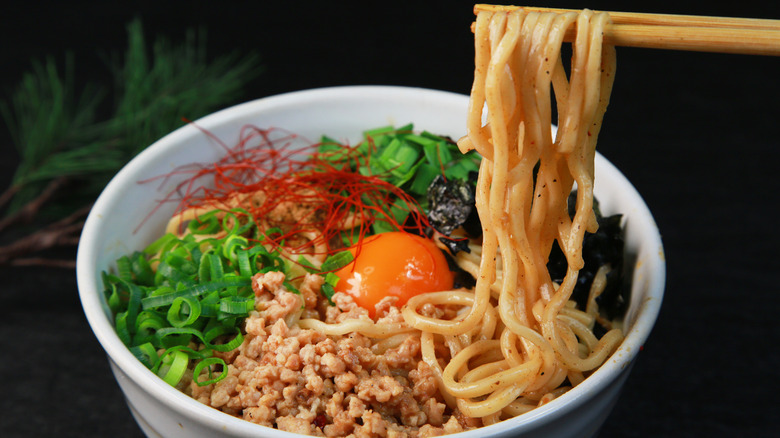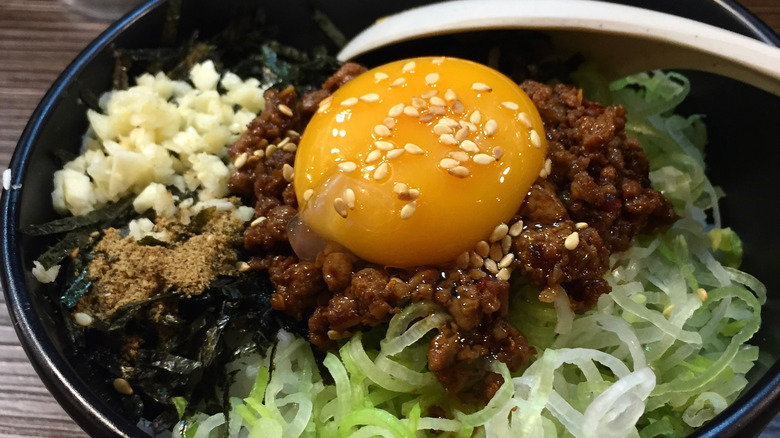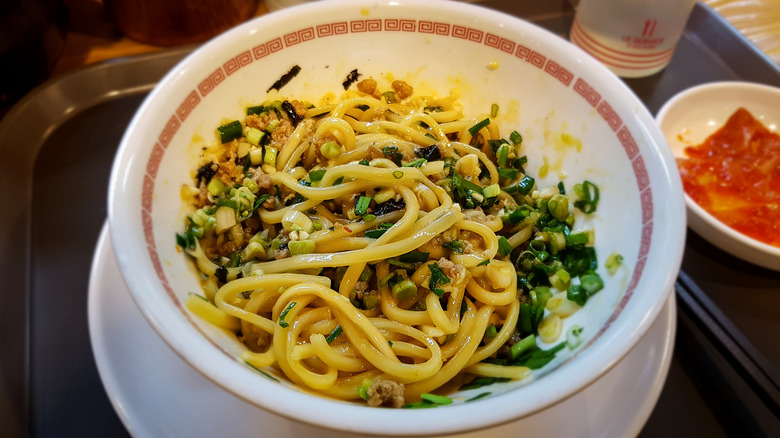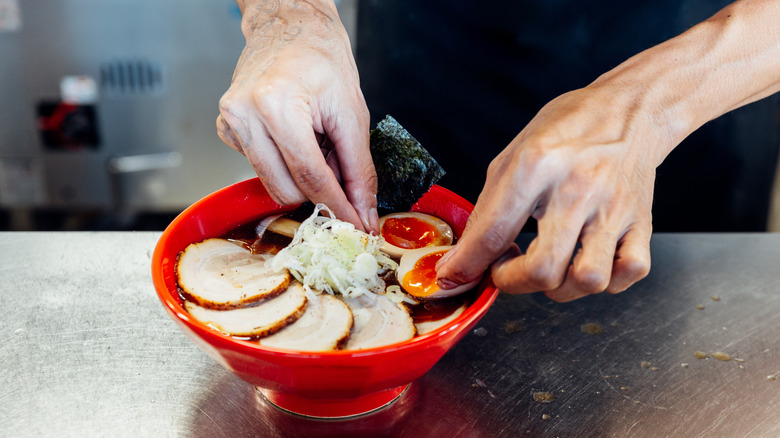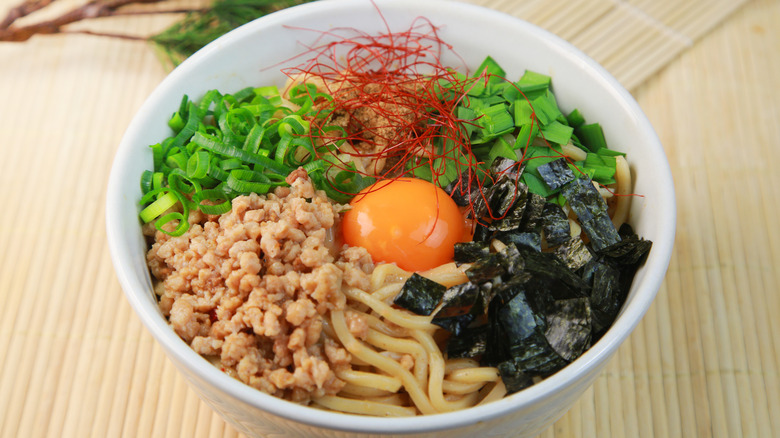Mazemen: The Broth-Less Ramen Dish You Should Know
Yup, the photo above shows a bowl of ramen. You may be wondering, where is the Chasu pork? Where is the broth? When you think of ramen, you probably imagine glistening wheat noodles in a milky broth, topped with the perfect jammy egg and bean sprouts. Ramen comes in all types of broth: there's shoyu ramen which has a clear soy sauce broth; then there is miso broth which utilizes the fermented bean paste as a base; and shio broth which has a salty seafood base, per MasterClass.
However, this newer type of ramen has no broth at all. Mazemen, which directly translates to "mixed noodles" in Japanese, includes all of the basic ingredients of ramen without the broth, according to ramen chef Yuji Haraguchi on First We Feast. Mazemen (or mazesoba) is a thick, creamy noodle dish that combines Taiwanese flavors with Japanese ramen, packing in the spicy punch that ramen lovers can't get enough of.
What is mazemen?
Mazemen is a broth-less ramen that usually comes with spicy minced pork, chopped chives or green onion, an egg yolk or onsen tamago (soft-cooked egg), and tare (the flavor base of the broth). The wheat noodles tend to be much thicker than the ones in normal ramen, leaving for the textural feel of pasta, Chef Nakamura shared with Edible Manhattan. According to IIKO Mazesoba, this broth-less noodle was inspired by Taiwanese flavor profiles, earning its name "Taiwan Mazesoba."
Contrary to popular belief, mazemen did not come from China, but from Nagoya, Japan. Taiwanese chef Guo Mingyu invented the first version of this Taiwanese ramen in the 1970s at his restaurant, Misen. Mingyu added Taiwanese flavors and spices to Japan's favorite noodle dish, bringing a twist to the normally savory broth. The addition of Taiwanese-style spicy minced pork was well received by customers, so this dish's popularity spread.
The Taiwan mazesoba was a dry version of Mingyu's Taiwanese ramen, and it was first served in Menya Hanabi in 2008 in Nagoya, Japan. This is the mazemen we know today, which earned its name as mixed noodles since it came with no broth. Menya Hanabi's mazemen is said to come with Taiwanese-style minced pork, chopped chives, green onions, fishmeal, and an egg yolk.
What does mazemen taste like?
Edible Manhattan describes mazemen as a combination of Italian and Japanese culinary traditions. The dish's alkali noodles are by far the thickest type of ramen noodles, almost as thick as udon. These cold, chewy noodles are placed in a spicy, garlicky base, and topped with spicy minced pork. Because hot minced pork is added to cold noodles, mazemen is usually served at room temperature.
The spicy ground pork is reminiscent of Taiwanese minced pork, which is ground pork braised in soy sauce, sugar, and spices. Mazemen is a crowd-pleaser due to the contrast between the gritty minced meat and the eggy noodles, which are all coated in yolk and a spicy tare base. Topped with freshly chopped chives and green onions, this dry ramen encompasses the necessities of a satisfying dish: creaminess from the egg, spiciness from the tare, protein from the minced pork, and freshness from the raw vegetables.
What is the difference between mazemen, ramen, and tantanmen?
Mazemen is a type of ramen. In regular ramen, the soup portion is always combined with the flavoring agent or tare after an order is received (per The Takeout). The most famous categories of tare are shoyu (soy sauce), miso, and shio (salty seafood base). When assembling mazemen, the chef skips this marriage of broth and tare by flavoring the noodles with the tare itself. The mazemen usually contains all elements of standard ramen: various toppings, tare, and alkali wheat noodles.
The difference is usually found in the way the egg is prepared and the thickness of the noodles. The egg in a bowl of soupy ramen is usually a shoyu tamago (soy sauce marinated egg) — a soft or hard-boiled egg with a browned outer layer and a jammy center. However, the mazemen usually comes with a raw egg yolk or an onsen tamago, which is a Japanese soft-cooked egg. The chef cracks the egg on top of the mazemen, leaving something that looks like a more translucent and gooey poached egg. This acts as the binding agent for an otherwise dry dish, coating everything in a salty, creamy sauce.
Since mazemen is a Taiwanese-inspired dish, it contains spices and ingredients that are usually left out in other types of ramen such as grated garlic, Chinese spice powder, and ginger. This spicy dry ramen is not to be confused with the tantanmen, which is another type of ramen inspired by a Chinese dish (Sichuanese Dan Dan noodles), per Woks of Life. Mazemen doesn't contain the Sichuan doubanjiang or spicy bean paste in tantanmen, but many ramen restaurants serve a combination of the two dishes. Oddly enough, Dan Dan noodles are a dry, mixed noodle dish, but the tantanmen has broth.
Where you can find mazemen
Mazemen can be found at many ramen shops all throughout Japan and the United States. On your search for mazemen, you will find that it isn't exactly one thing or the other. Most mazemen dishes contain thick noodles with minced pork, chives, and egg yolk. But every chef has their own variation of the dry noodle dish, as shown in Ivan Orkin's mazemen – which has a tiny splash of broth on thin noodles.
The next time you're craving ramen on a hot summer's day, you can switch it up by ordering this fun, cold noodle dish. If you're a Japanese food aficionado, you could go through the effort of making it yourself with Andrew Le's mazemen recipe. Most of the ingredients can be found at your local grocery store, with a few specialty items like Chinese five-spice powder and ramen noodles that call for a trip to an Asian supermarket. It's a refreshing take on the Taiwanese-inspired ramen, with cherry tomatoes, crushed peanuts, and cilantro that satisfies your ramen craving year-round.
